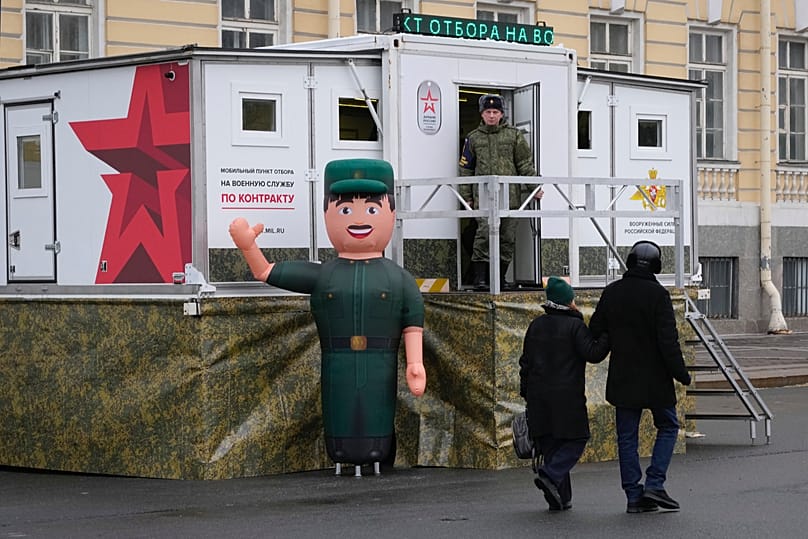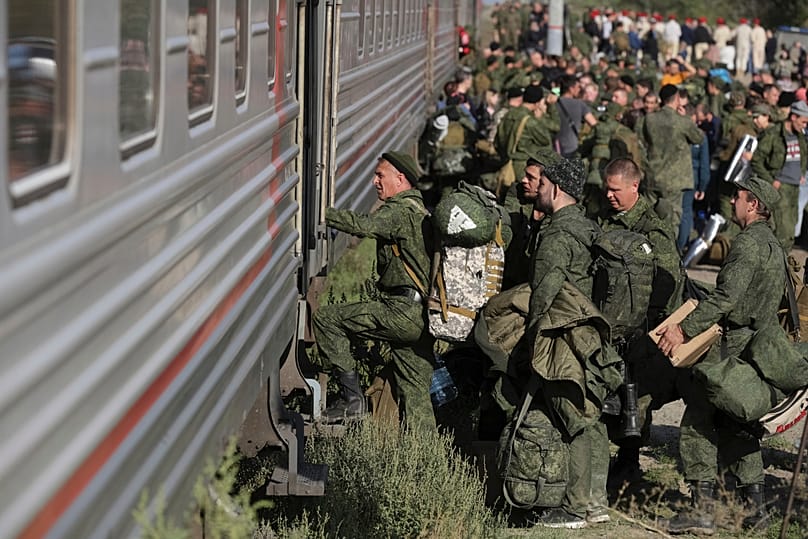Moscow has now claimed to have included parts of Ukraine’s Donetsk, Luhansk, Zaporizhzhia and Kherson regions into Russia’s Southern Military District, as it moves closer to formalising the forced conscription of Ukrainians in the temporarily occupied territories.
The Kremlin has claimed to have officially incorporated the temporarily occupied parts of Ukraine’s Donetsk, Luhansk, Zaporizhzhia and Kherson regions into Russia’s Southern Military District, a move which would allow Moscow to expand forced conscription in those places.
Russia-occupied Crimea has already been included in this district, according to Ukraine’s Centre for Countering Disinformation.
“The Kremlin is intensifying its repressive mobilisation policy, laying the groundwork for further illegal conscription of Ukrainians in the temporary occupied territories to compensate for its own military losses”, the centre stated.
How does Moscow force Ukrainians to fight in the Russian army?
Russia’s forced passportisation campaign in Ukraine has been ongoing since Moscow’s first invasion in 2014 and the consequent unilateral annexation of Crimea.
After launching the full-scale invasion in 2022, the Kremlin extended this policy to other territories that came under Russian occupation.
Those who refuse to get a Russian passport in the occupied territories of Ukraine do not have access to healthcare, education, social benefits or even humanitarian aid. Given that these people cannot travel and leave the occupied territories, their lives become extremely difficult.
In March, the Kremlin ordered all Ukrainians living in the Russia-occupied territories to obtain Russian passports or “leave” by 10 September.
The campaign resulted in Ukrainian nationals being forcefully conscripted into the Russian army and sent to fight against their own country.
Since the start of the all-out war in 2022 until summer 2024, Russia has mobilised approximately 300,000 men from the local population in occupied Ukraine, according to the Eastern Human Rights Group and the Institute for Strategic Studies and Security (ISRS). These numbers have been backed by Ukraine’s intelligence services.
Moscow formalising year-round military conscription
On Tuesday, Russian President Vladimir Putin signed a law on year-round conscription into the army — a significant shift from Moscow's traditional two-year conscription cycle.
Prior to the legislative change, young men were drafted twice a year for a year of compulsory service.
The conscripts are officially barred from deployment abroad, but many of them are offered and pressured into signing contracts with Russia’s Defence Ministry and are then sent to Ukraine. Even without an agreement, conscripts were already sent to illegally annexed Crimea.
The bill’s authors say the measure is intended to ease pressure on military conscription offices and streamline their operations, which include conducting physicals and assigning conscripts to various military branches.
They insist that, even though the bill makes conscription year-round, it stipulates that conscripts will enter military service only during a few spring and summer months, as before.
The Russian military has called up between 130,000 and 160,000 draftees during each round of conscription.
Russia has gradually increased the size of its army
Since the beginning of Moscow’s full-scale invasion of Ukraine, Russia has had an army of 1 million troops and has been gradually increasing its size as the fighting dragged on.
Last year, Putin ordered the number of active soldiers to be increased by 180,000 to 1.5 million. He said last month that the military has over 700,000 troops fighting in Ukraine.
As part of their efforts to combat draft evasion, authorities earlier this year launched an electronic register of conscripts to serve online summonses in some Russian regions.
Moscow also introduced a series of legal restrictions for those who ignore the summonses, including banning their bank transactions, suspending their driver's licenses and blocking foreign travel.
Amid Russian military setbacks early in the fighting, Putin ordered a “partial mobilisation” of 300,000 reservists in the fall of 2022, a widely unpopular move that prompted hundreds of thousands to flee abroad to avoid being called for service.
While Putin’s decree held the door open for calling up more reservists, the Kremlin has changed course and focused on bolstering its forces with volunteers, who were offered relatively high wages and other benefits.
Russian authorities reported that about 440,000 volunteers joined in 2024, and another 336,000 people signed military contracts this year.
But even as the military has sought to attract more volunteers, lawmakers approved another bill Tuesday that stipulates using reservists for protecting “critically important facilities” in some regions — a measure its authors said was intended to bolster defences against Ukrainian drones that have ranged more than 1,000 kilometres deep inside Russia.
The measure will not apply to all reservists. Only those who signed contracts to remain in the active reserve will be affected.


















